Beta-secretase-1 elevation in transgenic mouse models of Alzheimer's disease is associated with synaptic/axonal pathology and amyloidogenesis: implications for neuritic plaque development
- PMID: 20092570
- PMCID: PMC2869535
- DOI: 10.1111/j.1460-9568.2009.07017.x
Beta-secretase-1 elevation in transgenic mouse models of Alzheimer's disease is associated with synaptic/axonal pathology and amyloidogenesis: implications for neuritic plaque development
Abstract
The presence of neuritic plaques is a pathological hallmark of Alzheimer's disease (AD). However, the origin of extracellular beta-amyloid peptide (Abeta) deposits and the process of plaque development remain poorly understood. The present study attempted to explore plaque pathogenesis by localizing beta-secretase-1 (BACE1) elevation relative to Abeta accumulation and synaptic/neuritic alterations in the forebrain, using transgenic mice harboring familial AD (FAD) mutations (5XFAD and 2XFAD) as models. In animals with fully developed plaque pathology, locally elevated BACE1 immunoreactivity (IR) coexisted with compact-like Abeta deposition, with BACE1 IR occurring selectively in dystrophic axons of various neuronal phenotypes or origins (GABAergic, glutamatergic, cholinergic or catecholaminergic). Prior to plaque onset, localized BACE1/Abeta IR occurred at swollen presynaptic terminals and fine axonal processes. These BACE1/Abeta-containing axonal elements appeared to undergo a continuing process of sprouting/swelling and dystrophy, during which extracellular Abeta IR emerged and accumulated in surrounding extracellular space. These data suggest that BACE1 elevation and associated Abeta overproduction inside the sprouting/dystrophic axonal terminals coincide with the onset and accumulation of extracellular amyloid deposition during the development of neuritic plaques in transgenic models of AD. Our findings appear to be in harmony with an early hypothesis that axonal pathogenesis plays a key or leading role in plaque formation.
Figures


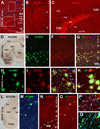
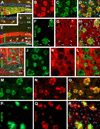
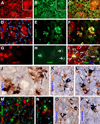
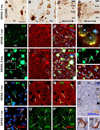
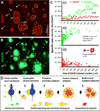
Similar articles
-
Presynaptic dystrophic neurites surrounding amyloid plaques are sites of microtubule disruption, BACE1 elevation, and increased Aβ generation in Alzheimer's disease.Acta Neuropathol. 2016 Aug;132(2):235-256. doi: 10.1007/s00401-016-1558-9. Epub 2016 Mar 18. Acta Neuropathol. 2016. PMID: 26993139 Free PMC article.
-
BACE1 elevation is involved in amyloid plaque development in the triple transgenic model of Alzheimer's disease: differential Aβ antibody labeling of early-onset axon terminal pathology.Neurotox Res. 2012 Feb;21(2):160-74. doi: 10.1007/s12640-011-9256-9. Epub 2011 Jul 2. Neurotox Res. 2012. PMID: 21725719 Free PMC article.
-
β-Secretase-1 elevation in aged monkey and Alzheimer's disease human cerebral cortex occurs around the vasculature in partnership with multisystem axon terminal pathogenesis and β-amyloid accumulation.Eur J Neurosci. 2010 Oct;32(7):1223-38. doi: 10.1111/j.1460-9568.2010.07376.x. Epub 2010 Aug 18. Eur J Neurosci. 2010. PMID: 20726888 Free PMC article.
-
BACE1: the beta-secretase enzyme in Alzheimer's disease.J Mol Neurosci. 2004;23(1-2):105-14. doi: 10.1385/JMN:23:1-2:105. J Mol Neurosci. 2004. PMID: 15126696 Review.
-
Alzheimer's disease.Subcell Biochem. 2012;65:329-52. doi: 10.1007/978-94-007-5416-4_14. Subcell Biochem. 2012. PMID: 23225010 Review.
Cited by
-
Neurite orientation dispersion and density imaging reveals white matter and hippocampal microstructure changes produced by Interleukin-6 in the TgCRND8 mouse model of amyloidosis.Neuroimage. 2019 Nov 15;202:116138. doi: 10.1016/j.neuroimage.2019.116138. Epub 2019 Aug 28. Neuroimage. 2019. PMID: 31472250 Free PMC article.
-
Application of computational methods for the design of BACE-1 inhibitors: validation of in silico modelling.Int J Mol Sci. 2014 Mar 24;15(3):5128-39. doi: 10.3390/ijms15035128. Int J Mol Sci. 2014. PMID: 24663084 Free PMC article.
-
7,8-dihydroxyflavone prevents synaptic loss and memory deficits in a mouse model of Alzheimer's disease.Neuropsychopharmacology. 2014 Feb;39(3):638-50. doi: 10.1038/npp.2013.243. Epub 2013 Sep 11. Neuropsychopharmacology. 2014. PMID: 24022672 Free PMC article.
-
Presynaptic dystrophic neurites surrounding amyloid plaques are sites of microtubule disruption, BACE1 elevation, and increased Aβ generation in Alzheimer's disease.Acta Neuropathol. 2016 Aug;132(2):235-256. doi: 10.1007/s00401-016-1558-9. Epub 2016 Mar 18. Acta Neuropathol. 2016. PMID: 26993139 Free PMC article.
-
BACE1 elevation is involved in amyloid plaque development in the triple transgenic model of Alzheimer's disease: differential Aβ antibody labeling of early-onset axon terminal pathology.Neurotox Res. 2012 Feb;21(2):160-74. doi: 10.1007/s12640-011-9256-9. Epub 2011 Jul 2. Neurotox Res. 2012. PMID: 21725719 Free PMC article.
References
-
- Arendt T. Alzheimer's disease as a disorder of dynamic brain self-organization. Prog Brain Res. 2005;147:355–378. - PubMed
-
- Bard F, Cannon C, Barbour R, Burke RL, Games D, Grajeda H, Guido T, Hu K, Huang J, Johnson-Wood K, Khan K, Kholodenko D, Lee M, Lieberburg I, Motter R, Nguyen M, Soriano F, Vasquez N, Weiss K, Welch B, Seubert P, Schenk D, Yednock T. Peripherally administered antibodies against amyloid beta-peptide enter the central nervous system and reduce pathology in a mouse model of Alzheimer disease. Nat. Med. 2000;6:916–919. - PubMed
-
- Blanchard V, Moussaoui S, Czech C, Touchet N, Bonici B, Planche M, Canton T, Jedidi I, Gohin M, Wirths O, Bayer TA, Langui D, Duyckaerts C, Tremp G, Pradier L. Time sequence of maturation of dystrophic neurites associated with Abeta deposits in APP/PS1 transgenic mice. Exp. Neurol. 2003;184:247–263. - PubMed
-
- Borchelt DR, Ratovitski T, van Lare J, Lee MK, Gonzales V, Jenkins NA, Copeland NG, Price DL, Sisodia SS. Accelerated amyloid deposition in the brains of transgenic mice coexpressing mutant presenilin 1 and amyloid precursor proteins. Neuron. 1997;19:939–945. - PubMed
-
- Cai H, Wang Y, McCarthy D, Wen H, Borchelt DR, Price DL, Wong PC. BACE1 is the major beta-secretase for generation of Abeta peptides by neurons. Nat. Neurosci. 2001;4:233–234. - PubMed
Publication types
MeSH terms
Substances
Grants and funding
LinkOut - more resources
Full Text Sources
Medical
Molecular Biology Databases

